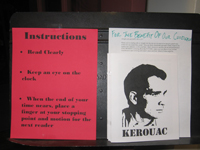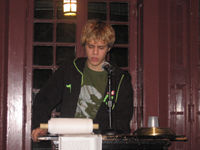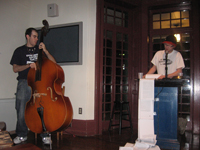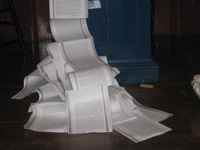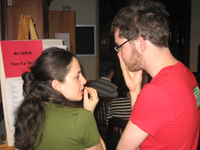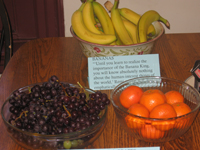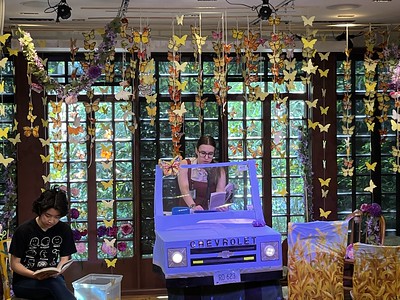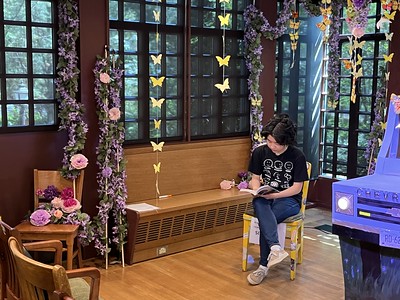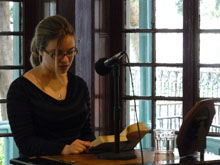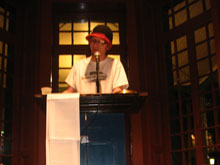Marathon Reading Program
April 20, 2023: Ocean Vuong's On Earth We're Briefly Gorgeous
This year we're reading 'On Earth We’re Briefly Gorgeous, a novel by Ocean Vuong that details the fraught yet undeniable love between a single mother and her son, and offers a brutally honest exploration of race, class, and masculinity. You are welcome to stop by anytime during the day to read, listen to the reading and sample some of the foods referenced in the book, which will be available at various times throughout the day.
April 21, 2022: Haruki Murakami's Kafka on the Shore
For our first annual Bernheimer Symposium, KWH Program Coordinator Erin Gautsche invented for us what has become an annual tradition. Each year, the Hub selects a book to read aloud, straight through, and we celebrate the book with extravagant decorations and food, all derived from the text. This year’s book is Haruki Murakami’s Kafka on the Shore, a story in which cats talk, fish fall from the sky, and spirits slip out of their bodies to make love or commit murder.
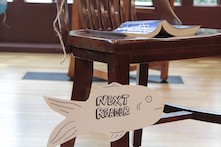
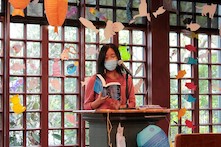
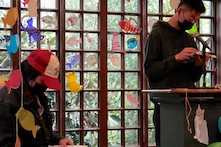
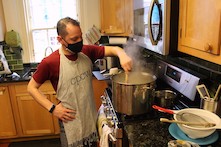
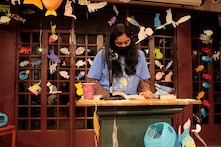
April 15, 2021: Lewis Carrol's Alice in Wonderland
This year we're reading Alice’s Adventures
in Wonderland and Through the Looking Glass – and anyone can sign up for a ten-minute reading slot.
We encourage readers to use your Zoom backgrounds to get creative and immerse yourself in Wonderland. Some options have created by our staffers, all of which can be found and downloaded here.
We’ll be having a raffle filled with cool gifts available for entry to all readers. If you’re on campus or in Philadelphia, we will be giving out grab bags full of otherworldly reader treats.
We will also have t-shirts available to order, featuring a design by our amazing staffer

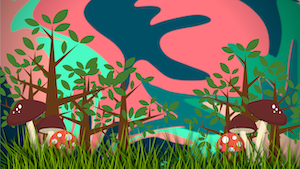
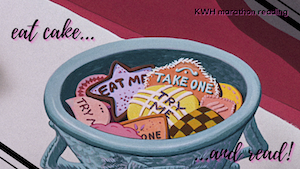

April 25, 2019: Emily Wilson's The Odyssey
We celebrated Emily Wilson’s stunning translation of The Odyssey by reading it aloud straight through from beginning to end. Sam Claypoole (C’20) claimed the first ten-minute chunk of our marathon, ten-hour reading, followed by over fifty people who helped shoulder the epic task, including faculty and students from the Classics Department. People visited throughout the day to check on our progress, but longtime marathon reading buff Harry Saffren sat through the entire event, as he has every year since our marathon reading of On the Road in 2007. We sustained our energy with an Odyssean feast of Mediterranean cheeses, olives, and einkorn flatbread reproduced from an ancient recipe by bakers at Lost Bread — all sourced by Jamie Png (C’06), who led our culinary research work. And an amazing crew of students — Zoe Braccia (C’20), Yiwei Chai (C’22), Ashley Codner (C’21), Quinn Gruber (C’22), Husnaa Hashim (C’22), Tasha Hutnick (C’20), Emily Rush (C’19), and Rachel Swym (C’22) — transported us to the ancient world with elaborate murals, interactive athletic challenges, hand-painted 3D paper pomegranates, and other imaginative decorations and props. Thanks to their efforts, and with engineering support from KWH program coordinator Alli Katz, a giant cardboard cyclops loomed over the entire event, keeping an eye on everything.
April 5, 2018: Shirley Jackson We Have Always Lived in the Castle
This year's marathon reading book was Shirley Jackson's mystery classic We Have Always Lived in the Castle. Yes! Starting at 3:00 PM and continuing until it's done, we read the book from start to finish. To help celebrate the book, we decorated the KWH to reflect the lonely small-town estate in Vermont at the center Jackson's novel and cooked food from the book (including from the final fateful meal).
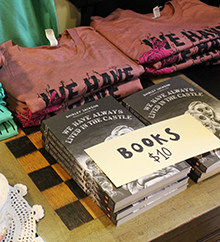

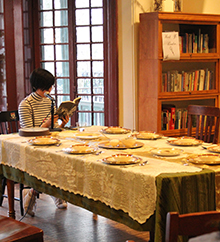
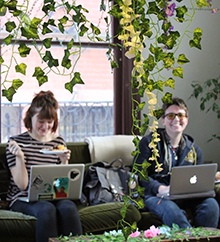
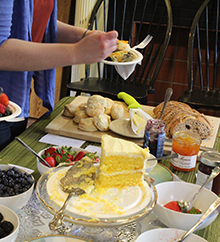
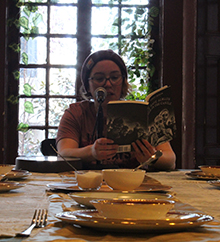
March 30, 2017: Douglas Adams The Hitchhiker's Guide to the Galaxy

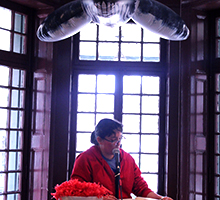
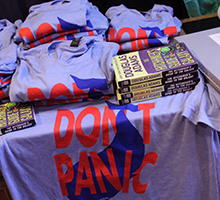
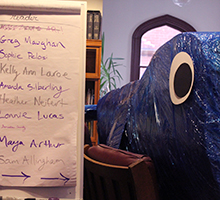
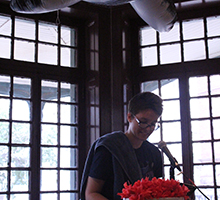
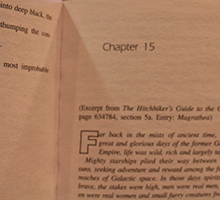
March 31, 2016: Italo Calvino If on a Winter's Night a Traveler
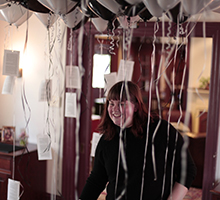
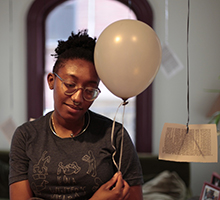
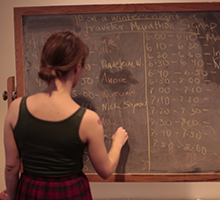
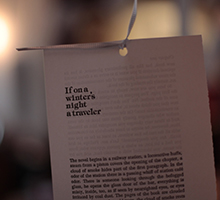
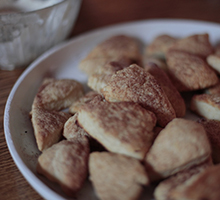
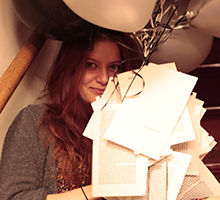
April 23, 2015: Gabriel García Márquez's 100 Years of Solitude
It takes a couple of styrofoam fire ants, a wedding cake, one hundred or so yellow paper flowers, and a whole roast pig (not to mention about thirteen-and-a-half hours) to read aloud all 417 pages of Gabriel García Marquez’s One Hundred Years of Solitude. At least that’s what we discovered during this year’s marathon reading, when we decorated the house to evoke the fictional village of Macondo and read the book from start to finish, with a menu by Santi Cortes (W’16), cake by resident pâtissier Tyler Burke (C’17), plantains by Gabriel Ojeda-Sague (C’16), folded fish by Meg Pendoley (C’16), and readings by dozens of Hub members who each took a ten-minute turn at the podium.
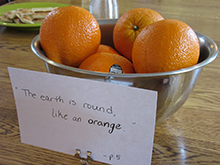
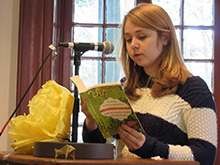
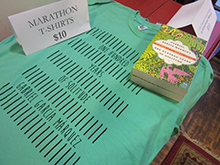
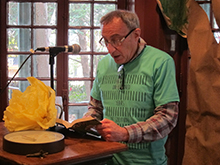
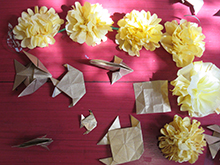
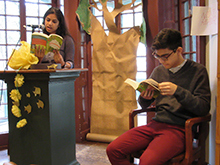
February 20, 2014: Toni Morrison's Jazz
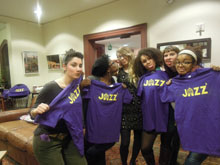
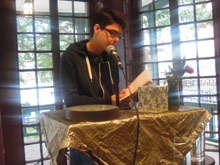
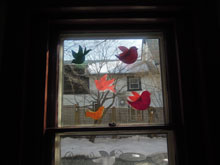
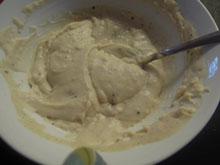
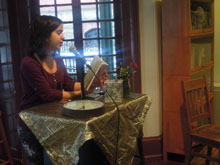
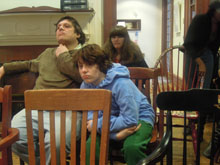
March 21, 2013: Truman Capote's In Cold Blood
Our seventh annual Marathon Reading transformed the Writers House into a crime scene:
cordoned off by police tape, dummy corpses made with the help of J. M. Conway (C’16) and
Gabe Morales (C’16) spilled across our living room. The book was
In Cold Blood, Truman
Capote’s groundbreaking 1966 “nonfiction novel,” the true account of the murder of a
Kansan family and the subsequent trial. We read the whole thing through in just under
12 hours.To capture the grimness of the subject (as if the bodies were not enough), we
served the same food the killers ate before committing their crimes: a diner feast of
steak, succotash, hominy, and apple pie. Jess Bergman (C’14) helped lighten the mood by
designing a t-shirt that re-imagined Holcomb, Kansas, as a tourist destination. The reading
of the book lasted well into the night — only a few brave souls remained to enjoy the
murderers’ last meal when it was finally served at 11:15 PM. Among the most dedicated
was marathon junkie
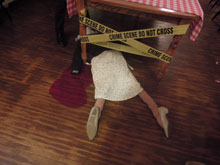
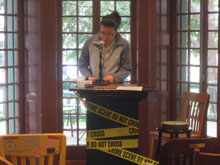
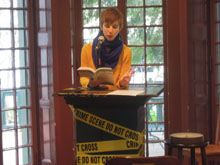
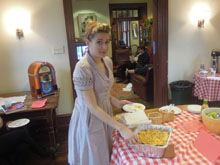
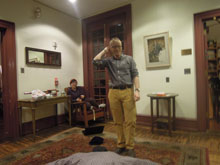
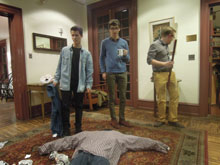
March 15, 2012: Thomas Pynchon's The Crying of Lot 49
"Shall I project a world?" Oedipa Maas wonders before she dives into the bizarre underworld of conspiracies and counter-cultures that sets the scene for The Crying of Lot 49. Projecting a world is precisely what we'll be doing during our Marathon Reading of Thomas Pynchon's 1966 postmodern cult-classic, when we bring to life Oedipa's romp through paranoid-schizophrenic suburban California, populated by acid-tripping housewives, Nazi psychiatrists, corporate anarchists, and evidence-burnng philatelists.
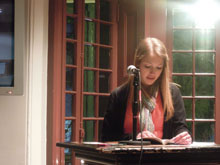
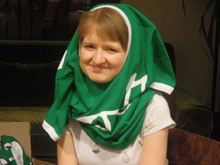
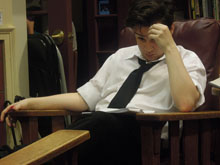
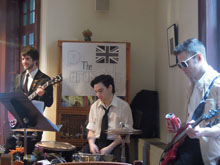
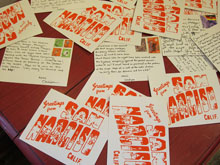
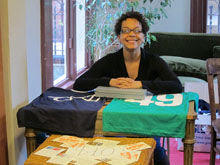
February 18, 2011: Virginia Woolf's Mrs. Dalloway
Published in 1925, Viriginia Woolf's Mrs. Dalloway is widely considered to be a classic work of twentieth century literature, and an exemplary novel of the modernist style. Taking place in one hot London day in June, just five years after Armistice, the book tells the story of Mrs. Clarissa Dalloway as she prepares to throw a party that evening, at which all of Westminster high society, she hopes, will be in attendance. Along the way, with her characteristic and quite simply gorgeous prose, Woolf also tells the story of trauma and eroding confidence in the Empire following the carnage of the Great War, and of people struggling to find happiness and meaning in the doubt-ridden worlds of post-war London and middle-age. We might call Woolf's style "stream of consciousness," and then we might all groan at that cliched phrase. But while Joyce or Faulkner worked to represent the free-associating inner voices of others, and then an intermingling of these voices, Woolf's narrative in Mrs Dalloway is distinctly her own. It runs through the people of London like a stream runs over different terrains, through different landscapes, over rocks and shallow places, into rivers, but is always the same stream.
The fifth annual Marathon Reading at the Writers House was the first to feature a female writer and a non-American (and yorkshire puddings!). Flowers, teapots, and fashionable hats were found everywhere as we recreated the floral and fluid world Clarissa Dalloway's London. Over the course of six hours and forty minutes, nearly fifty readers took turns inhabiting Woolf's voice, creating their own stream of unique timbres, accents, and styles, and revealing a music to the prose that one's inner reading voice overlooks. All in all, the day was extraordinarily amusing!
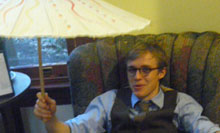
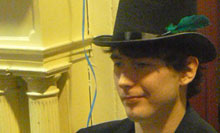
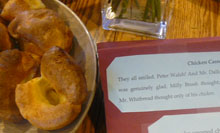
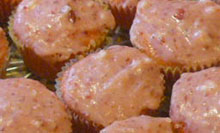
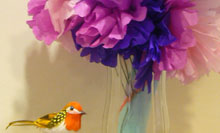
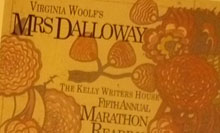
April 2, 2010: F. Scott Fitzgerald's The Great Gatsby
On April 10, 1925, F. Scott Fitzgerald published The Great Gatsby, which has been lauded in the following decades as his masterpiece. Heralded as "the great American novel" and the seminal work on the fallacy of the American Dream, the book appears on TIME Magazine's list of Top 100 English-language Novels of All Time, and ranks #2 on the Modern Library's list of 100 Best Novels of the 20th Century. The story dances through the glitz and glamour of the Roaring Twenties, and exposes the superficiality of its values and the deceptiveness of its promise. 2010 will mark the 85th anniversary of the book's publication, and the 70th anniversary of the author's death. In honor of what T.S. Eliot famously called "the first step that American fiction [had] taken since Henry James", we dedicated our annual marathon reading to celebrating this acclaimed novel.
The Writers House was saturated by 1920s imagery and advertisements, full of food inspired by Gatsby's lavish parties, and swinging to the syncopation of early jazz. Readers gathered in the Arts Cafe to contribute to the performance of The Great Gatsby.
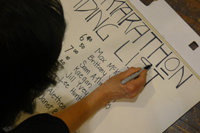
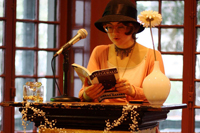
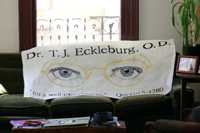
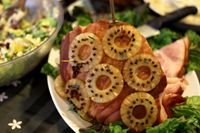
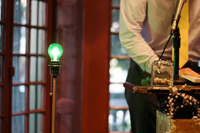
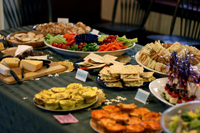
April 3, 2009: Kurt Vonnegut's Slaughterhouse Five
Slaughterhouse-Five is the sixty-ninth entry to the American Library Association's list of the 100 Most Frequently Challenged Books of 1990-2000. Kurt Vonnegut was mourning the follies of the world with laughter long before the term "black humorist" had been coined. In a series of fictional fables he confronted a remarkable range of topics: space, religion, creeping technology, how to love the unlovable, and even doomsday, which, as he gently observes, "could easily be next Wednesday." The popularity of Slaughterhouse Five is due, in part, to its timeliness; it deals with many issues that were vital to the late sixties: war, ecology, overpopulation, and consumerism. Klinkowitz, writing in Literary Subversions: New American Fiction and the Practice of Criticism, sees larger reasons for the book's success: "Kurt Vonnegut's fiction of the 1960s is the popular artifact which may be the fairest example of American cultural change. . . . Shunned as distastefully low-brow . . . and insufficiently commercial to suit the exploitative tastes of high-power publishers, Vonnegut's fiction limped along for years on the genuinely democratic basis of family magazine and pulp paperback circulation. Then in the late 1960s, as the culture as a whole exploded, Vonnegut was able to write and publish a novel, Slaughterhouse Five, which so perfectly caught America's transformative mood that its story and structure became best-selling metaphors for the new age."
Surrounded by computer screens and sounds, multimedia installations, delicious cuisine, and varied hand-made collectibles, a series of readers gathered at the Writers House to deliver in one non-linear breath, Slaughterhouse Five.
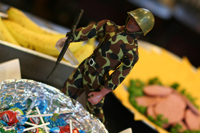
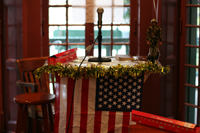

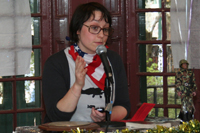
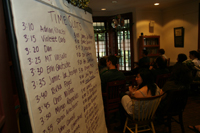
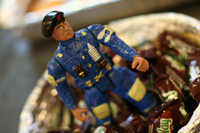
March 27, 2008: Vladimir Nabokov's Lolita
"When Vladimir Nabokov's Lolita was first published in 1955 in Paris, it was soon banned for its controversial content. Yet as an underground readership grew, the novel gained international attention, and, as a result, the bans were lifted. Immediate responses to the work were understandably mixed. Many critics condemned it as pornographic trash, citing its 'obscene' descriptions of a pedophile's sexual activities. Others applauded the work's originality and sparkling wit. The novel has now, however, gained almost universal approval as a brilliant tour de force. Readers find middle-aged narrator and protagonist Humbert Humbert to be both perpetrator and victim of his disastrous obsession with the young Lolita. In his record of his relationship with her, Humbert becomes a complex mixture of mad lecher who 'breaks' the life of a young girl and wild romantic who suffers in his pursuit of his unattainable ideal. Donald E. Morton, in his book Vladimir Nabokov, argues that 'what makes Lolita something more than either a case study of sexual perversion or pornographic titillation is the truly shocking fact that Humbert Humbert is a genius who, through the power of his artistry, actually persuades the reader that his memoir is a love story. Nabokov's technical brilliance and beautiful, evocative language help bring this tragic character to life.'"
2008 marked the 50th anniversary of the American publication of Vladimir Nabokov's infamous Lolita, a book that somehow managed to survive ahead of its time and overcome cultural backlash and governmental censorship to become one of the 20th century's canonical texts. Because we at the Writers House have always been fans of literature's rebels, we knew that this momentous occasion would not pass without joyous incident. We produced, fertilized, and incubated our scheme for celebration.
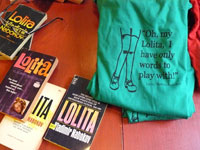
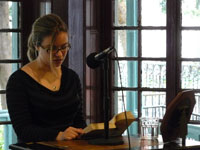
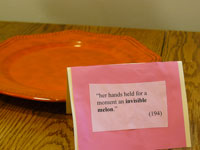
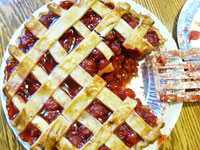
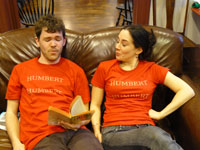
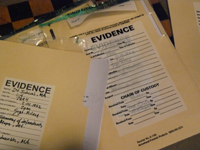
We have also created a playlist.
- Lolita- The Marathon Reading Mix
- Zip-A-Dee-Do-Dah - James Baskett
- When You Were Sweet 16 - Perry Como
- Daddy-O - Louis Jordan and His Tympani Five
- I Wish I Didn't Love You So - Vaughn Monroe
- Careless Hands - Mel Torme
- Confess - Patti Page
- Love Somebody - Doris Day
- Someday (You'll Want Me to Want You) - Jerry Lee Lewis
- I'm in the Mood - John Lee Hooker
- Jezebel - Franklie Lane
- A Guy is a Guy - Doris Day
- You Belong to Me - Jo Stafford
- Hold Me, Thrill Me, Kiss Me - Mel Carter
- Enjoy Yourself - Guy Lombardo
Jaunary 25, 2007: Jack Kerouac's On the Road
Jack Kerouac's On the Road, a rollicking, stream-of-consciousness novel, burst onto the literary scene in 1957, rocketing Kerouac to fame and inspiring a multi-generational obsession with "the road." On the Road, a rapid-fire adventure tale of crossing the country (and back again) solo and with friends, discovering drugs, jazz, and the "bug" of travel, became a benchmark for the Beat Generation.
Kerouac wrote the novel in a three-week marathon burst on twelve reams of paper he taped together and referred to as "the scroll." In celebration of the 50th anniversary of the book, and the spirit of the book, the Writers House hosted a marathon reading of our own scroll, featuring local luminary guest readers and accompanied by improvisational jazz musicians.
